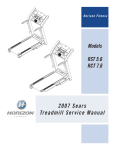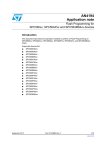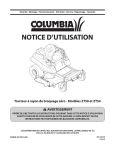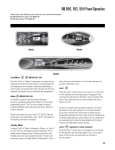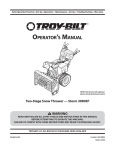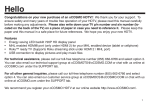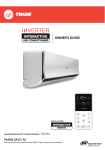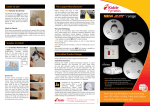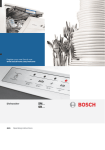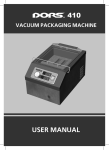Download LLC Water Level Control System User Manual 09-1366
Transcript
/ LLC Water Level Control System / User Manual 09-1366 1 Contents Note This manual contains vital information for the proper installation and operation of your cooling tower. Carefully read the manual before installation or operation of the tower and follow all instructions. Save this manual for future reference. Quick Start Guide .......................................................................................................4 Description ...................................................................................................................5 Operation ......................................................................................................................5 Water Makeup Function ............................................................................................7 HAND-OFF-AUTO Switch ........................................................................................7 Internal Components ..................................................................................................8 Electrode Probe Assembly .......................................................................................9 Operation Sequence Illustrations............................................................................9 Water Makeup Control Sequence .......................................................................10 High-Level Alarm Sequence ..................................................................................11 High-Level Cutoff Sequence .................................................................................11 Low-Level Alarm Sequence ...................................................................................12 Low-Level Cutoff Sequence ..................................................................................12 Makeup and High Circuit Card Checking ..........................................................13 Low Circuit Card Checking ...................................................................................14 Electrode Probe Part Numbers ............................................................................15 Relay Circuit Card Part Numbers.........................................................................16 Part Numbers ............................................................................................................16 Wiring Diagrams....................................................................................................... 17 The following defined terms are used throughout this manual to bring attention to the presence of hazards of various risk levels, or to important information concerning the life of the product. Warning Indicates presence of a hazard which can cause severe personal injury, death or substantial property damage if ignored. Caution Indicates presence of a hazard which will or can cause personal injury or property damage if ignored. Note 2 Indicates special instructions on installation, operation or maintenance which are important but not related to personal injury hazards. Introduction These instructions are intended to assure that field connections are completed properly and the control system operates for the maximum time possible. Since product warranty may depend on your actions, please read these instructions thoroughly prior to operation. If you have questions about the operation and/or maintenance of this control system and you do not find the answers in this manual, please contact your Marley sales representative. Warning Hazard of electrical shock or burn. Be sure to turn off power to the panel before servicing. If working on equipment out of site of panel disconnect, lockout using standard lockout procedure. Safety First The Marley control system uses UL listed components installed in accordance with the National Electric Code. The location of the cooling tower and field installation of the control system can affect the safety of those responsible for installing, operating or maintaining the tower and controls. However, since SPX Cooling Technologies does not control the tower location, or field installation, we cannot be responsible for addressing safety issues that are affected by these items. Warning The following safety issues should be addressed by those responsible for installation, maintenance or repair of the tower and controls: t"DDFTTUPBOEGSPNUIFDPOUSPMQBOFMJODMVEJOHUIFDVTUPNFS supplied main disconnect/branch circuit protection.) t1SPQFSHSPVOEJOHPGFMFDUSJDBMDPOUSPMDJSDVJUT t4J[JOH BOE QSPUFDUJPO PG CSBODI DJSDVJUT GFFEJOH UIF DPOUSPM panel. t2VBMJGJDBUJPOPGQFSTPOTXIPXJMMJOTUBMMNBJOUBJOBOETFSWJDF the electrical equipment. These are only some of the safety issues that may arise in the design and installation process. Marley strongly recommends that you consult a safety engineer to be sure that all safety considerations have been addressed. Other safety issues are addressed in literature supplied with your tower. You should closely review the literature prior to installing, maintaining or repairing your tower. 3 Quick Start Guide Connect incoming power here. Panel requires 120VAC 1 phase, 6 amp power with ground. If a makeup solenoid circuit is provided, connect the solenoid wires here at points 4A and 2A. This circuit provides 120 VAC power for the solenoid. Connect alarm and/or cutoff control wiring to the grey terminal points. Connect water level probe wiring to the blue terminals. The probes are generally located in the cold water basin of the cooling tower. To avoid water getting into the control panel, all conduit entries should be into the bottom of the enclosure. Note If the control panel is furnished with a water makeup selector switch located on the right-hand side of the enclosure: HAND: position: Solenoid will energize. OFF: position: Solenoid is de-energized AUTO: Solenoid will operate depending on water level in relation to water probe height. 4 Operation Description The Liquid Level Control systems are used to accomplish five different functions: t8BUFS.BLFVQ t)JHI8BUFS"MBSN t-PX8BUFS"MBSN t)JHI8BUFS$VUPGG t-PX8BUFS$VUPGG The most common application of a water level control system is water makeup. The system regulates the amount of water in the tower basin and keeps it within normal operating levels. This makeup system is used to control a remotely installed water solenoid valve. When the water level drops below a prescribed, preset level, the solenoid valve is energized by the control system to fill the basin to its proper level. High and low water alarms can be utilized to give warnings associated with abnormal operating water levels. To provide indication of these types of alerts, the control system provides dry contacts to interface with various digital control systems or can be connected to user supplied alarm indicators to signal when corrective action is required. Low-water cutoffs are commonly used to protect pumps from operating without sufficient water. When used in unattended operating environments, the low-water cutoff is configured to shut the pump off, thus preventing costly repairs. Dry contacts can be wired directly in series with pilot duty controls or to digital control systems to initiate the shutdown of protected equipment during low-water situations. Operation The LLC water level control system consists of special purpose liquid sensing relays on one or more individual circuit cards connected to a probe assembly located in the cold-water basin. Each circuit card contains one relay and external signaling is provided by each of these special purpose cards. The individual relay provides a “Form C” normally open and normally closed dry contact. The circuit card activates the relay using “through the water” continuity by way of the senor probes located in the cold-water basin of the cooling tower. 5 Operation Utilizing water’s ability to conduct electricity, a circuit path can be established between one probe tip and the other. Current conducts through the water across probes of dissimilar length. One common or reference probe is present in all systems and is shared by all functions of the system. This probe can be identified by its length. It is the longest probe in the system and extends the deepest into the basin. The current path is routed between all other probe tips and this one “common”. When the water level reaches the shorter probe, the circuit is completed and the relay responds, opening or closing relay contacts corresponding to a fixed level. For low-level control, the ground reference probe and a slightly shorter probe provide the circuit. When the water level drops below this tip, the continuity between this probe and the reference probe is interrupted and the relay contacts transfer. The distance from the tip of the low probe to the floor of the basin determines the minimum water level that is allowed before an alarm is produced or pump operation is interrupted. The number of additional probes is determined by the individual application. As an example, in a “water makeup” system there are three probes. One reference and two standard or short-tipped probes. The tip of the reference probe is normally positioned slightly above the basin floor with the additional probe tips positioned at different heights dictated by their specific function. The Makeup system would have one probe at a height to begin or start filling the basin and another positioned higher to complete or stop filling. A probe for a High Alarm or High Cutoff would be positioned at a level to activate when the basin water exceeds its normal operating level and logically a Low Alarm or Low Cutoff would be positioned to detect a low water level nearer the bottom of the basin. Again, signaling is achieved in two ways. High Level and Makeup cards react when the water provides a completed circuit or continuity between its sensor and the reference probe. The second type of signal is for Low Level detection. The Low Level cards react when the water is not present and opens the circuit or disrupts the current flow between its probe and the reference. A water level control system can be configured to meet various combination requirements. Since one individual circuit card is responsible for each function, the size and circuitry varies in proportion to the number of operations desired. For example, a water level makeup control will require a control panel with one circuit relay card and three probes. A system configured for water makeup that includes a high alarm and a low alarm, will require three circuit cards and five probes—one circuit card for the water makeup option, one for high operation and one for low. 6 Operation Water Makeup Function A system is designed for alarms and/or cutoff indication only would not be equipped with the water makeup function. The circuitry for water makeup in the LLC control panel provides an independent circuit breaker for direct connection to a 110-120VAC water solenoid valve. This added feature allows customer installation without having to provide an additional power circuit to energize the solenoid. The solenoid is connected to terminals 2A and 4A as represented on the control’s specific wiring diagram. Purpose and Function of the HAND-OFF-AUTO Switch Located on the right side of the control’s enclosure is a HAND-OFF-AUTO switch. This switch is used primarily at cooling tower startup and in maintenance procedures where the tower basin is empty or has been drained. When the tower’s basin needs to be manually filled, the switch is placed in the HAND position. This selection bypasses the probe assembly’s feedback and directly energizes the solenoid valve connected to the water supply. Once the cooling tower basin is filled, the switch is placed in the AUTO position to allow the adjusted probe assembly to monitor and sustain the proper operating level. Placing the switch in the OFF position completely interrupts any monitoring or fill action normally provided by the LLC control panel. Normal tower operation depends upon the HAND-OFF-AUTO switch being positioned in the AUTO mode at all times. 7 Operation Inside view of a LLC Control Panel with Makeup, High Alarm, and Low Alarm. Internal Components of the LLC Control Panel LLC control panels are built to UL and CUL standards and are designed to provide the numerous configurations needed for cooling tower applications. All LLC control panels include a main circuit breaker with an additional circuit breaker and a HAND-OFF-AUTO switch provided when the system includes a water makeup circuit. The additional circuit breaker provides an exclusive control circuit for a 120VAC water solenoid valve. High and low circuit relay cards and the appropriate terminal connections comprise the rest of the components necessary for the specific configuration. The raised terminal strip provides easier access to make the necessary connections of the water probe assembly and customer interface. 8 Operation Stainless Steel Electrode Probe Assembly The electrode probe tips are stainless steel suspended from a noncorrosive PVC enclosure box with 20 feet of wire for each probe. A galvanized or stainless steel stilling chamber is installed over the probes to calm the water for accurate readings. Illustrations Describing Operation Sequence The next three pages are simplified illustrations representing the sequence of operation for each type of circuit card. t1BHFo.BLFVQ t1BHFo)JHI"MBSN t'JHVSFo-PX"MBSN t'JHVSFo)JHI$VUPGG t'JHVSFo-PX$VUPGG Note Reference is the one common probe to the total system configuration. 9 Operation Water Makeup Control – Sequence of Operation 1. Relay Contact Open DE-ENERIZED CONTROL PANEL Power OFF CIRCUIT CARD with RELAY 2. Valve Closed 2 120VAC 4A Relay Contact Closed ENERIZED CONTROL PANEL Power ON CIRCUIT CARD with RELAY 120VAC 4A 13 14 15 Relay Contact Open Water Level Rising ENERIZED CONTROL PANEL Power ON 5. Valve Closed 2 120VAC 4A Relay Contact Open Water Level Rising ENERIZED CONTROL PANEL Power ON CIRCUIT CARD with RELAY 6. Valve Closed Relay Contact Closed REFERENCE PROBE REFERENCE PROBE ENERIZED CONTROL PANEL Power ON CIRCUIT CARD with RELAY Valve Open 2 SOLENOID VALVE 120VAC 4A 13 14 15 MAKE-UP OFF PROBE MAKE-UP ON PROBE Water Level Dropping SOLENOID VALVE MAKE-UP ON PROBE 13 14 15 MAKE-UP ON PROBE 10 120VAC 4A MAKE-UP OFF PROBE REFERENCE PROBE 120VAC 4A MAKE-UP OFF PROBE Valve Open 13 14 15 2 SOLENOID VALVE 13 14 15 Water Level Rises To MAKEUP OFF Probe CIRCUIT CARD with RELAY 2 SOLENOID VALVE MAKE-UP ON PROBE REFERENCE PROBE CIRCUIT CARD with RELAY ENERIZED CONTROL PANEL Power ON MAKE-UP OFF PROBE MAKE-UP ON PROBE 4. Relay Contact Closed 13 14 15 MAKE-UP OFF PROBE Water Level Valve Open 2 SOLENOID VALVE 3. REFERENCE PROBE MAKE-UP OFF PROBE MAKE-UP ON PROBE Water Level Drops Below MAKEUP ON Probe REFERENCE PROBE SOLENOID VALVE Operation High Level Alarm – Sequence of Operation 1. Relay Contact Closed DE-ENERIZED CONTROL PANEL Power OFF 2. Relay Contact Open CIRCUIT CARD with RELAY 5 6 ENERIZED CONTROL PANEL Power ON Relay Contact Closed CIRCUIT CARD with RELAY 5 CUSTOMER CONNECTION 6 5A ENERIZED CONTROL PANEL Power ON CIRCUIT CARD with RELAY 5 CUSTOMER CONNECTION 6 5A 13 16 13 16 HIGH ALARM PROBE Water Level Rising REFERENCE PROBE CUSTOMER CONNECTION 5A 13 16 HIGH ALARM PROBE Water Level 3. HIGH ALARM PROBE High Alarm Condition REFERENCE PROBE REFERENCE PROBE High Level Cutoff – Sequence of Operation 1. Relay Contact Open DE-ENERIZED CONTROL PANEL Power OFF 2. Relay Contact Closed CIRCUIT CARD with RELAY ENERIZED CONTROL PANEL Power ON 8 7 CIRCUIT CARD with RELAY 8 8A 7 CUSTOMER CONNECTION 8 13 17 HIGH CUTOFF PROBE REFERENCE PROBE ENERIZED CONTROL PANEL Power ON 8A CUSTOMER CONNECTION 13 17 Water Level Relay Contact Open CIRCUIT CARD with RELAY 8A 7 3. 13 17 HIGH CUTOFF PROBE Water Level Rising CUSTOMER CONNECTION REFERENCE PROBE HIGH CUTOFF PROBE High Cutoff Condition REFERENCE PROBE 11 Operation Low Level Alarm – Sequence of Operation 1. Relay Contact Closed DE-ENERIZED CONTROL PANEL Power OFF 2. Relay Contact Open CIRCUIT CARD with RELAY 9 10 ENERIZED CONTROL PANEL Power ON Relay Contact Closed CIRCUIT CARD with RELAY 9 CUSTOMER CONNECTION 10 9A ENERIZED CONTROL PANEL Power ON CIRCUIT CARD with RELAY 9 CUSTOMER CONNECTION 10 9A 13 18 Water Level 3. 9A 13 18 LOW ALARM PROBE REFERENCE PROBE 13 18 LOW ALARM PROBE Water Level Dropping CUSTOMER CONNECTION Low Alarm Condition REFERENCE PROBE LOW ALARM PROBE REFERENCE PROBE Low Level Cutoff – Sequence of Operation 1. Relay Contact Open DE-ENERIZED CONTROL PANEL Power OFF 2. Relay Contact Closed CIRCUIT CARD with RELAY 9 10 ENERIZED CONTROL PANEL Power ON 9 10 9A LOW ALARM PROBE ENERIZED CONTROL PANEL Power ON CIRCUIT CARD with RELAY 9 CUSTOMER CONNECTION 10 9A 9A 13 19 REFERENCE PROBE 12 Relay Contact Open CIRCUIT CARD with RELAY CUSTOMER CONNECTION 13 19 Water Level 3. Water Level Dropping 13 19 LOW ALARM PROBE REFERENCE PROBE Low Cutoff Condition LOW ALARM PROBE REFERENCE PROBE CUSTOMER CONNECTION Checkout Procedure Water Makeup, High Alarm and High Cutoff – Circuit Card LLC24B2F50N If an individual circuit relay card is suspected of causing a problem, use one of the next two checkout procedures to verify its’ condition. The first procedure is used when checking the Makeup, High Alarm or High Cutoff cards. 0 0 H Load Contacts NC L NO C COM 115 VAC The second procedure, on the next page, is used to check a Low Alarm or Low Cutoff card. Perform each step as directed. H Load Contacts Probes NC L NO C COM 115 VAC AC Line Probes AC Line Step1 Step 2 1—Disconnect all wires from relay card. Connect power to the relay. 1. Attach a jumper to C and L (probe terminals). Meter should still read 0 ohms. 2—Connect ohmmeter across contacts COM and NO. Meter should read 0 ohms (closed contact). 0 H infinity Load Contacts NC L NO C COM 115 VAC H Load Contacts Probes NC L NO C COM 115 VAC AC Line Probes AC Line Step 3 Step 4 1. Touch a jumper to the H and C terminals. Meter should read “infinity” (open contact). 1. Remove the jumper from L to C. Meter should read 0 ohms, indicating contacts have closed. 2. Remove the jumper from H to C, leaving the jumper from L to C in place. Contacts should remain open. Note—Check out procedure for card LCC24BF50N (Makeup, High Alarm and High cutoff) Uses N.O. (normally open) contacts verses N.C for card LCC24Af50N. See next Page. 13 Checkout Procedure Low Alarm and Low Cutoff – Circuit Card LLC24A2F50N 0 0 H Load Contacts NC L NO C COM 115 VAC H Load Contacts Probes NC L NO C COM 115 VAC AC Line Probes AC Line Step1 Step 2 1—Disconnect all wires from relay card. Connect power to the relay. 1. Attach a jumper to C and L (probe terminals). Meter should still read 0 ohms. 2—Connect ohmmeter across contacts COM and NC. Meter should read 0 ohms (closed contact). infinity Load Contacts NC L NO C COM 115 VAC 0 H H Load Contacts Probes NC L NO C COM 115 VAC AC Line Probes AC Line Step 3 Step 4 1. Touch a jumper to the H and C terminals. Meter should read “infinity” (open contact). 1. Remove the jumper from L to C. Meter should read 0 ohms, indicating contacts have closed. 2. Remove the jumper from H to C. Contacts should remain open. Note—Check out procedure for card LCC24AF50N (Low Alarm and Low Cutoff) uses N.C. (normally closed) contacts verses N.O. for card LCC24BF50N. See previous page. 14 Parts List Threaded Probe Tip Standard Item D20643 Includes red cap and small hat-shaped copper crimp-on connector Probe, Reference/GND “Tip Only” Item D20718 Electrode Probe Assembly Additional part numbers can be found on the next page 15 Parts List Relay Circuit Card Item number % – Used for Makeup, High Alarm and High Cutoff (LLC24B2F50N) Item number % – Used for Low Alarm and Low Cutoff (LLC24A2F50N) 16 .BSMFZ*UFN %FTDSJQUJPO H-O-A Switch % Makeup Relay Card % High Alarm Relay Card % High Cutoff Relay Card % Low Alarm Relay Card % Low Cutoff Relay Card $ Standard Probe Sensor (Complete with tip and 20 ft wire) % Standard Probe Sensor (Complete with tip and 50 ft wire) % Reference / GND Probe Sensor (Complete with tip and 20 ft wire) % Reference / GND Probe Sensor (Complete with tip and 50 ft wire) % Standard Probe Sensor Stainless Steel Tip % Reference / GND Probe Sensor Stainless Steel Tip Terminal Blocks Kit (2 Gray, 2 Blue and 1 End) D81756 EMI Filter 17 18 19 20 21 22 23 24 25 26 27 28 29 30 31 32 33 34 35 36 37 38 39 40 41 42 43 44 45 46 47 7401 WEST 129 STREET | OVERLAND PARK, KANSAS 66213 UNITED STATES | 913 664 7400 | [email protected] | spxcooling.com In the interest of technological progress, all products are subject to design and/or material change without notice. ©2009 SPX Cooling Technologies, Inc. | Printed in USA Manual 09-1366
















































